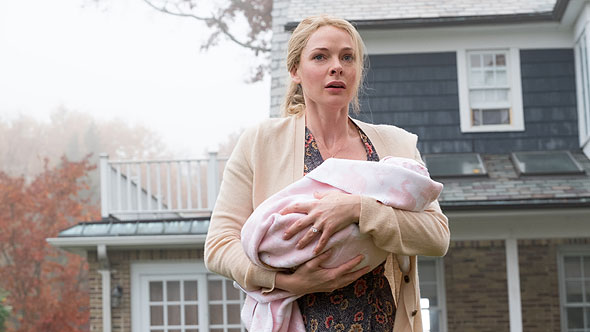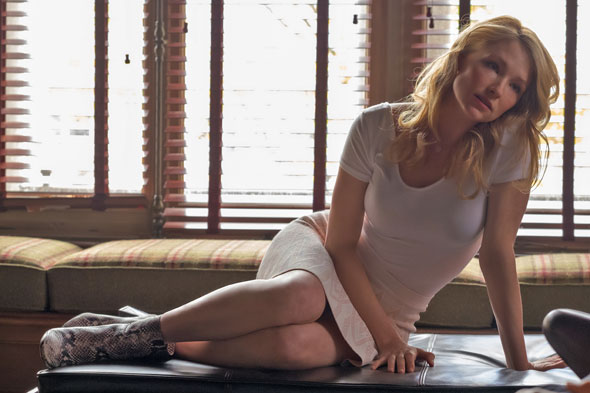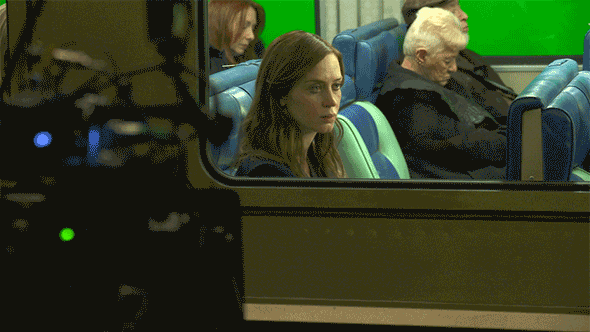Changing Settings, Camera Strategies, and Making a Train on a Stage Look Like One on a Track
The Girl on the Train, opening this weekend in the U.S. and internationally, is the film version of a runaway bestseller. Part voyeuristic Hitchcockian thriller and part Gone Girl-esque character study, Paula Hawkins' novel was a compelling read with multiple timelines unfolding simultaneously and a tricky lead character who drinks too much, can't remember whether or not she witnessed a murder, and may in fact have had something to do with the killing. Watch the trailer, below, then read on to learn more about the production, including how the filmmakers made a train on a Yonkers soundstage really look like it was chugging its way up the Hudson River Valley.
The film adaptation was fast-tracked when the novel by Paula Hawkins caught fire on its U.S. release.
Screenwriter Erin Cressida Wilson (Secretary) had already written a first draft when the book came out in the U.S. last year. When the book reached the top of the New York Times best-seller list within two weeks of publication, DreamWorks quickly hired Tate Taylor to direct. "They were like, 'We've got to get this thing made. We've got lightning in a bottle here. We've got to get it out for fall of 2016,'" Taylor told The New York Times. "So we just amped it up." Today, the book has been on that list for more than 80 weeks. [Source: The New York Times]

The novel's suburban setting was moved from London to Westchester County, New York.
Presumably to ensure a more familiar atmosphere for U.S. audiences, the story was moved from suburban London to suburban New York, where shooting took place in White Plains and various river towns. Location manager Joe Guest and production designer Kevin Thompson rode trains on the Metro-North and Long Island Rail Road lines to select the ideal location, eventually settling on the Metro-North Hudson Line, which heads straight up the Hudson River out of the city. The suburban homes and backyards Rachel spies on from her seat on the commuter train were shot miles away, in White Plains, New York. "The first thing that will strike British audiences watching The Girl on the Train is how huge the houses are," noted a decidedly skeptical reviewer in The Economist. [Source: Studio production notes, The Economist.]
It was shot on film.
According to IMDb's Technical Specifications, The Girl on the Train was shot on three-perf Super 35 Kodak Vision3 film stock with the ARRICAM LT and Zeiss Master Prime and Fujinon Alura lenses. "I wanted that real darkness," said cinematographer Charlotte Bruus Christensen (The Hunt). "There's a lot of shadows, darkness, pure blacks and characters coming out of — and disappearing into — blackness." [Source: IMDb, Studio production notes]

Cinematographer Charlotte Bruus Christensen devised three different shooting styles for the three main female characters.
For Rachel (Emily Blunt), the story's protagonist, Christensen worked up close and handheld. "The major part of this film is all about her mind," Christensen said. "She has the closeness, so she's right there in your face." Anna (Rebecca Ferguson) was shot with a stationary camera, often through glass, in order to emphasize a sense of distance. And Megan (Haley Bennett) was often shot with a moving camera, emphasizing the story's perspective on her character. "She's a girl who's running away," said Christensen. "Whenever she's on the move, we put her on a Steadicam. There's a floating feel, so she doesn't have her feet on the ground." [Source: Studio production notes]
Because Emily Blunt's character is an alcoholic, levels of intoxication had to be accounted for in the continuity.
Director Tate Taylor rated Rachel's intoxication on a four-point scale to keep her performance properly oriented from scene to scene. Prosthetics came into play, too, with mouthpieces designed to make her cheeks puffy and contact lenses giving her eyes a glazed-over look. And some shots were step-printed to further suggest Rachel's disorientation. "It gives an effect of staggering," DP Charlotte Bruus Christensen told The Wall Street Journal. "It feels unreal or dizzy in a way." [Source: The Wall Street Journal]

The shoot demanded both a real train and a fake train.
Real trains on the Metro-North line were shot on several weekends, and the production filmed over two Sundays at the Ardsley-on-Hudson Metro North station. But the real trick was building a train on a stage in Yonkers that could pass for the real thing. The production turned a salvaged train car into a movie set, with specially rebuilt sections that could be moved out of the way for the camera and a special wider aisle for moving film equipment. Surrounded by green screen, the train sat on a platform with two trusses and air-filled cushions connected to hydraulics that could move the car like a train on the tracks. Live-action plates of the Hudson Line environment were shot, then used to generate matching lighting patterns for a row of LED lights overhead. “So when we were inside the train car, the lighting that is coming into it will be similar to what plate shots were used," said production designer Kevin Thompson, "and it will slow down as the train is slowing down, and speed up when the train is going fast.” [Source: Studio production notes.]
Did you enjoy this article? Sign up to receive the StudioDaily Fix eletter containing the latest stories, including news, videos, interviews, reviews and more.










Leave a Reply